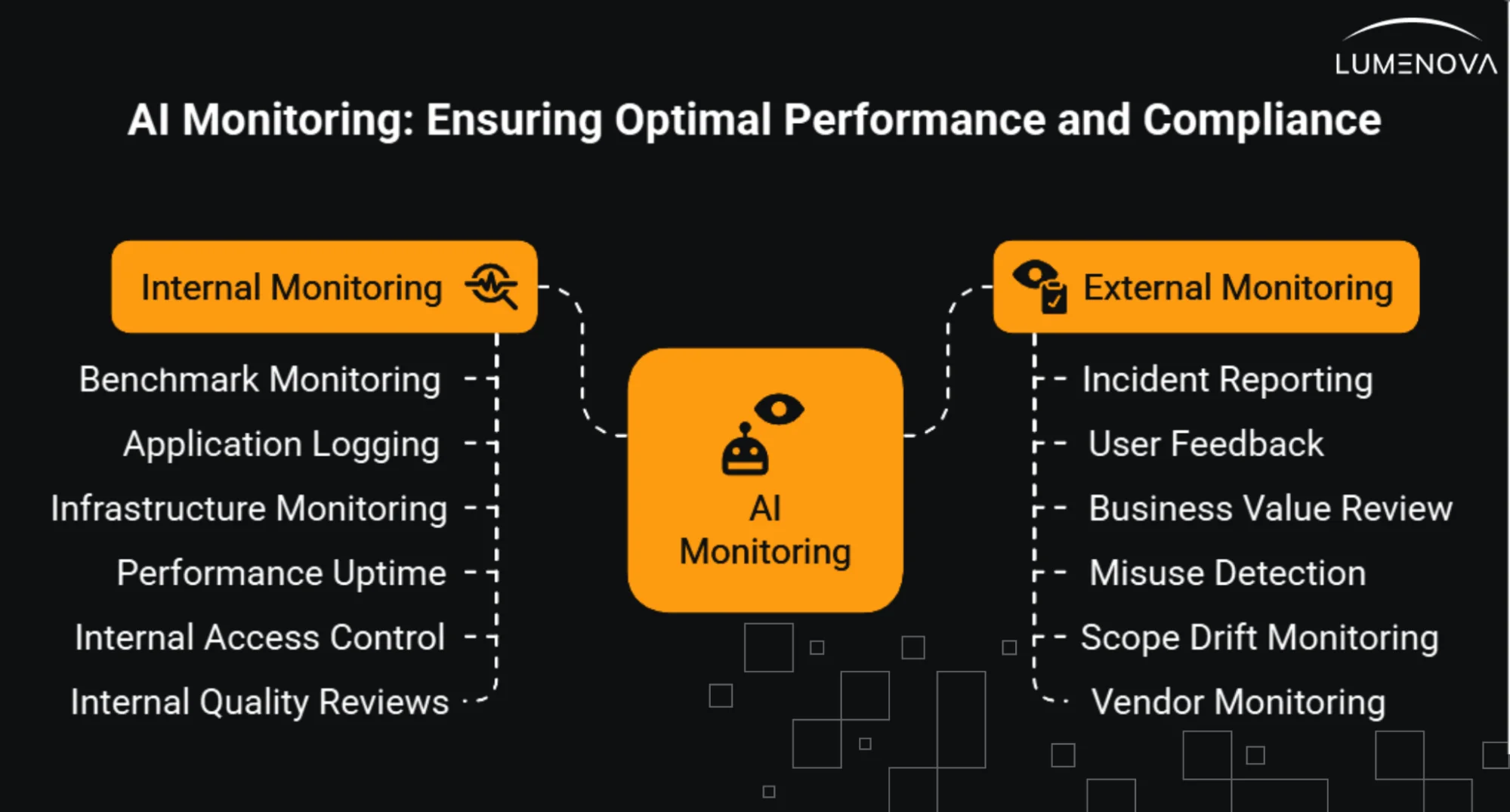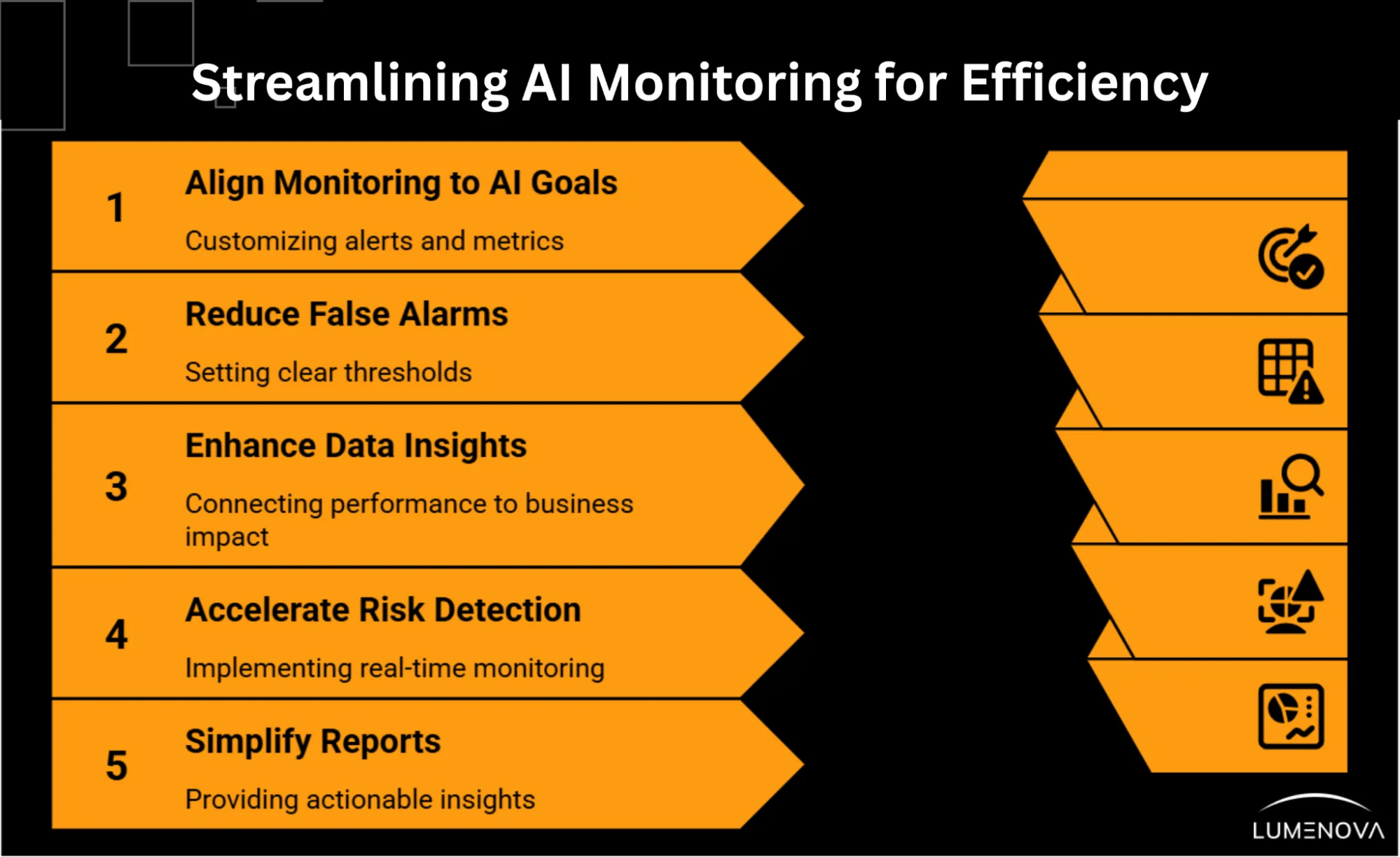March 25, 2025
How to Make Sure Your AI Monitoring Solution Isn’t Holding You Back

Contents
AI monitoring should help businesses work smarter, catch problems early, and make better decisions. But what if it’s doing the opposite? Some companies don’t realize that their monitoring system (which is meant to track the performance, fairness, and behavior of AI models) might actually be making things harder instead of easier.
Instead of simplifying workflows, a rigid or poorly designed AI monitoring solution can slow down operations, create extra work, and lead to confusion. Let’s look at the common ways AI monitoring can hurt efficiency, how to tell if it’s happening to you, and what you can do to fix it.

How AI Monitoring Can Reduce Efficiency
Enterprise AI governance is meant to streamline workflows and reduce risk, poorly implemented tools can do just the opposite, slowing teams down with noise, confusion, and unnecessary work. Here’s how:
- Too Many False Alarms: Some AI software flags minor changes as major problems. Your team might waste time checking issues that don’t matter, leading to alert fatigue. When real problems arise, they might get ignored.In the financial industry, false positives in fraud detection systems can have serious repercussions. For instance, legitimate transactions mistakenly identified as fraudulent can result in valid customers being turned away, leading to lost revenue and reputational damage. Additionally, resources are wasted investigating these false alarms, increasing operational costs.
These scenarios highlight the importance of implementing AI monitoring tools that minimize false positives to maintain operational efficiency and customer trust.
- Rigid One-Size-Fits-All Approach: Every AI system is different, but some monitoring tools assume they all work the same way. If a tool can’t adapt, it might miss key details or flag non-issues, making monitoring unreliable.For instance, Amazon’s AI recruiting tool was found to penalize resumes that included the word “women,” due to biased training data (an issue that went undetected because the system wasn’t tailored to catch gender-based disparities).
- Lack of Customization: If your AI governance software doesn’t let you adjust monitoring settings to fit your AI’s needs, you’ll struggle to get useful insights. This can make decision-making harder instead of easier.A FICO report found that 65% of companies couldn’t fully explain their AI models due to inflexible monitoring frameworks, creating barriers for regulatory compliance.
- Slow Response Time: Some monitoring tools can’t keep up with fast-changing AI models. If updates take too long, critical risks might go unnoticed.According to McKinsey, a major logistics provider saw AI performance degrade during real-time demand surges, but delays in monitoring alerts caused fulfillment disruptions and customer dissatisfaction.
- Disconnected Data: Monitoring that only tracks inputs and outputs without considering business impact can lead to blind spots in fairness, performance, and compliance.A ProPublica investigation found that the COMPAS AI tool used in US courtrooms disproportionately labeled Black defendants as high risk (despite no evidence of higher recidivism). The system lacked real-world impact monitoring.
Signs That Your AI Monitoring is Holding You Back
If your AI monitoring system is creating inefficiencies, you’ll likely notice some of the following problems:
- Your team spends more time investigating false alarms than addressing actual risks (while false positives are safer than missed threats, an overwhelming number can still drain time and distract from real issues).
- Reports are overloaded with unnecessary data, making it hard to spot important trends.
- Your monitoring system doesn’t provide insights into why AI decisions are being made.
- Performance metrics don’t align with business objectives, giving rise to irrelevant optimizations.
- Your monitoring tool can’t adapt to changes in your AI models or data.
If any of these sound familiar, it’s time to rethink your approach.
5 Steps to Eliminate AI Monitoring Inefficiencies
To make sure AI monitoring is helping rather than slowing you down, follow these key steps:

1. Make Monitoring Fit Your AI
Every AI system has different risks and goals. Your monitoring tool should allow you to set custom alerts, track the right metrics, and align with your business needs. Flexibility is key. Without it, you might either drown in unnecessary alerts or miss crucial risks. Choose a tool that lets you tweak its settings to match your AI model’s purpose and function.
2. Cut Down on False Alarms
Not every small change is a real issue. If your monitoring system sends alerts for every tiny fluctuation, your team will eventually ignore them. Define clear thresholds for what should trigger a response. Prioritize major risks while filtering out noise, so your team can focus on what truly matters.
3. Look Beyond Raw Data
Numbers don’t always tell the whole story. AI monitoring should provide insights that connect model performance to broader business impacts (for example, if a churn prediction model becomes less accurate, monitoring should show that this led to more customers leaving, an increase in support requests, and a drop in monthly revenue), helping teams understand the “why” behind decisions.
4. Speed Up Risk Detection
AI systems evolve fast. If your monitoring tool takes too long to detect risks, it might already be too late. Look for real-time monitoring solutions that can keep up with model updates, data changes, and business needs. Delayed alerts or slow data processing can be the difference between catching an issue early and facing a major failure.
5. Simplify Reports for Actionable Insights
Complex, cluttered reports slow down decision-making. Your monitoring system should deliver concise, actionable insights rather than overwhelming data dumps. Decision-makers don’t need pages of raw numbers; they need clear takeaways that guide action. The best platforms provide visual summaries, automated recommendations, and user-friendly reports that make AI risk management seamless.
What Makes Lumenova’s AI Governance Platform Stand Out
Lumenova AI’s mission is to make business processes more efficient. Unlike legacy systems that are clunky and difficult to use, our RAI platform is straightforward, adaptable, and easy to implement. Here’s how it helps:
- Receive Updates Instantly: You will be notified immediately so you can address problems as they arise.
- Custom Monitoring: Adjust settings to match your AI’s unique needs and business goals.
- Easy-to-Match Standards: Works with different AI systems without disrupting your workflow.
- Executive-Friendly Reports: Decision-makers get the insights they need without sifting through unnecessary data.
- All-In-One AI Risk Management: AI is managed in performance and compliance in several areas (Accountability, Fairness, Explainability & Interpretability, Validity & Reliability, Safety & Ethics, Security & Resilience, and Data Privacy).
Our platform streamlines the entire process so teams can make fast, informed decisions without unnecessary complexity. We eliminate redundant alerts, simplify reporting, and provide meaningful insights that help businesses stay compliant and competitive.
Conclusion
AI monitoring should help you do less, not more. If your system constantly triggers false alerts, overlooks critical risks, or makes decision-making more complex, it’s time to rethink your approach. The right monitoring tool should provide real-time insights, reduce unnecessary noise, and help teams focus on what truly matters.
Book a demo today to see how Lumenova AI can help you improve monitoring, reduce inefficiencies, and build AI systems you can trust.